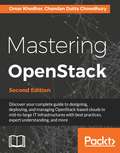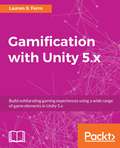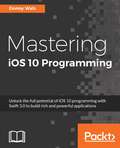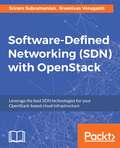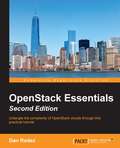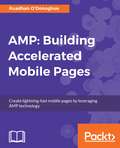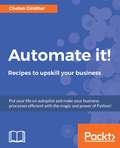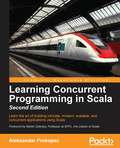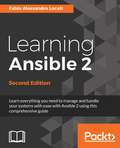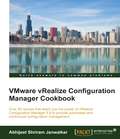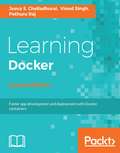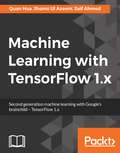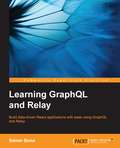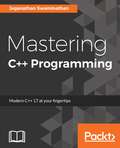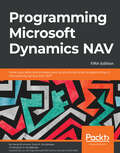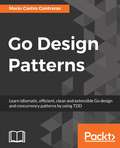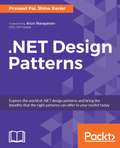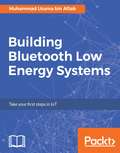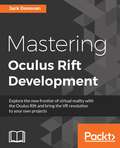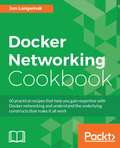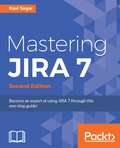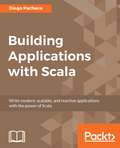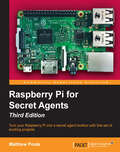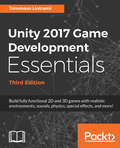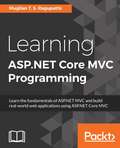- Table View
- List View
Mastering OpenStack - Second Edition
by Omar Khedher Chandan Dutta ChowdhuryDiscover your complete guide to designing, deploying, and managing OpenStack-based clouds in mid-to-large IT infrastructures with best practices, expert understanding, and more About This Book • Design and deploy an OpenStack-based cloud in your mid-to-large IT infrastructure using automation tools and best practices • Keep yourself up-to-date with valuable insights into OpenStack components and new services in the latest OpenStack release • Discover how the new features in the latest OpenStack release can help your enterprise and infrastructure Who This Book Is For This book is for system administrators, cloud engineers, and system architects who would like to deploy an OpenStack-based cloud in a mid-to-large IT infrastructure. This book requires a moderate level of system administration and familiarity with cloud concepts. What You Will Learn • Explore the main architecture design of OpenStack components and core-by-core services, and how they work together • Design different high availability scenarios and plan for a no-single-point-of-failure environment • Set up a multinode environment in production using orchestration tools • Boost OpenStack's performance with advanced configuration • Delve into various hypervisors and container technology supported by OpenStack • Get familiar with deployment methods and discover use cases in a real production environment • Adopt the DevOps style of automation while deploying and operating in an OpenStack environment • Monitor the cloud infrastructure and make decisions on maintenance and performance improvement In Detail In this second edition, you will get to grips with the latest features of OpenStack. Starting with an overview of the OpenStack architecture, you'll see how to adopt the DevOps style of automation while deploying and operating in an OpenStack environment. We'll show you how to create your own OpenStack private cloud. Then you'll learn about various hypervisors and container technology supported by OpenStack. You'll get an understanding about the segregation of compute nodes based on reliability and availability needs. We'll cover various storage types in OpenStack and advanced networking aspects such as SDN and NFV. Next, you'll understand the OpenStack infrastructure from a cloud user point of view. Moving on, you'll develop troubleshooting skills, and get a comprehensive understanding of services such as high availability and failover in OpenStack. Finally, you will gain experience of running a centralized logging server and monitoring OpenStack services. The book will show you how to carry out performance tuning based on OpenStack service logs. You will be able to master OpenStack benchmarking and performance tuning. By the end of the book, you'll be ready to take steps to deploy and manage an OpenStack cloud with the latest open source technologies. Style and approach This book will help you understand the flexibility of OpenStack by showcasing integration of several out-of-the-box solutions in order to build a large-scale cloud environment.. It will also cover detailed discussions on the various design and deployment strategies for implementing a fault-tolerant and highly available cloud infrastructure.
Gamification with Unity 5.x
by Lauren S. FerroBuild exhilarating gaming experiences using a wide range of game elements in Unity 5.x About This Book * Achieve your goals in a fun-filled way by creating gamification projects from scratch * Leverage the Unity 5.X toolkit to create stunning and appealing projects * Make your transition towards a pro project manager/ developer by learning tricks and techniques Who This Book Is For If you are a project manager, game developer, or programmer who wants to create successful end-to-end gamification projects from scratch, then this is the book for you. You do not need any previous experience of working with Unity 5.X. All the details required to make the most of gamifying your projects are provided in the book. What You Will Learn * Assess your learners' abilities by setting up challenges and quests * Implement the game elements that relate to the project into Unity * Publish your own task management application to better engage readers * Improve your design using methods of playtesting and iteration * Issue OpenBadges to recognize achievements and set up an online database to store your users achievements. In Detail Are you looking at implementing gamification techniques for your business and wondering where to get a complete rundown of all the tricks and techniques? Well, you have come to the right place! This book will start right from the basics such as gameplay elements and their functionalities before gradually moving onto creating your first gamification project from scratch. You'll be given the tools and shown how to perform various techniques for creating gamified applications in different contexts. Finally, you will implement various game elements into Unity, publish your own task management application, and get to know the best practices and approaches when designing gamified experiences. Style and approach This book takes a real-world case studies approach, moving ahead in a step-by-step tutorial manner. You will create your own project from scratch, and the practical examples will help you create a successful gamification project.
Mastering iOS 10 Programming
by Donny WalsUnlock the full potential of iOS 10 programming with Swift 3.0 to build rich and powerful applications About This Book • This practical guide will help you make the transition to professional iOS developer • Implement numerous powerful iOS 10 and Swift 3 techniques to build high-quality apps through this book • Get the most in-depth, advanced-level guide on the latest version of iOS and take a hands-on approach Who This Book Is For This book is for developers who have some experience with iOS and want to take their skills to next level by unlocking the full potential of latest version of iOS with Swift to build impressive applications. What You Will Learn • Write beautiful Swift code with Protocol-Oriented Programming and best practices • Create rich views and layouts with responsive animations and transitions. • Handle data, both from the web and offline • Integrate with iOS and improve the user experience with app extensions • Make sure that your app is of outstanding quality with XCTest • Measure and improve performance by using Xcode Instruments • Embrace the latest extension features in iOS 10 such as the new rich notifications, SiriKit, and iMessage In Detail With usage of apps growing rapidly, mobile application development has become the most sought-after skill set. Within the mobile market, iOS commands a massive presence and is a highly lucrative platform. The goal of our book is to help you become a professional developer by unleashing the full potential of iOS 10 to build applications. Written with the latest Swift version and following the latest Swift API design guidelines, you won't just learn how to program for iOS 10—you'll also learn how to write beautiful, readable, and maintainable Swift code that's in line with the industry's best-practices. The progression of the book reflects the real-world development flow: it will quickly brush on the essentials at the beginning and then move on to the advanced concepts crucial to building powerful applications. Within the book, you will build a couple of small applications that resemble applications you might want to build in the real world. You will be reading a mix of thorough background information and practical examples, so you'll know how to make use of a certain technique right away while you also get a great understanding of the how and why. Style and approach This book takes a no-frill approach and is very code-specific. The focus is on teaching advanced concepts through a series of small projects and standalone examples that help you gain expertise with various aspects of iOS application development.
Software-Defined Networking (SDN) with OpenStack
by Sriram Subramanian Sreenivas VorugantiLeverage the best SDN technologies for your OpenStack-based cloud infrastructure About This Book * Learn how to leverage critical SDN technologies for OpenStack Networking APIs via plugins and drivers * Champion the skills of achieving complete SDN with OpenStack with specific use cases and capabilities only covered in this title * Discover exactly how you could implement cost-effective OpenStack SDN integration for your organization Who This Book Is For Administrators, and cloud operators who would like to implement Software Defined Networking on OpenStack clouds. Some prior experience of network infrastructure and networking concepts is assumed. What You Will Learn * Understand how OVS is used for Overlay networks * Get familiar with SDN Controllers with Architectural details and functionalities * Create core ODL services and understand how OpenDaylight integrates with OpenStack to provide SDN capabilities * Understand OpenContrail architecture and how it supports key SDN functionality such as Service Function Chaining (SFC) along with OpenStack * Explore Open Network Operating System (ONOS) - a carrier grade SDN platform embraced by the biggest telecom service providers * Learn about upcoming SDN technologies in OpenStack such as Dragonflow and OVN In Detail Networking is one the pillars of OpenStack and OpenStack Networking are designed to support programmability and Software-Defined Networks. OpenStack Networking has been evolving from simple APIs and functionality in Quantum to more complex capabilities in Neutron. Armed with the basic knowledge, this book will help the readers to explore popular SDN technologies, namely, OpenDaylight (ODL), OpenContrail, Open Network Operating System (ONOS) and Open Virtual Network (OVN). The first couple of chapters will provide an overview of OpenStack Networking and SDN in general. Thereafter a set of chapters are devoted to OpenDaylight (ODL), OpenContrail and their integration with OpenStack Networking. The book then introduces you to Open Network Operating System (ONOS) which is fast becoming a carrier grade SDN platform. We will conclude the book with overview of upcoming SDN projects within OpenStack namely OVN and Dragonflow. By the end of the book, the readers will be familiar with SDN technologies and know how they can be leveraged in an OpenStack based cloud. Style and approach A hands-on practical tutorial through use cases and examples for Software Defined Networking with OpenStack.
OpenStack Essentials - Second Edition
by Dan RadezUntangle the complexity of OpenStack clouds through this practical tutorial About This Book * Navigate through the complex jungle of components in OpenStack using practical instructions * This book helps administrators, cloud engineers, and even developers to consolidate and control pools of compute, networking, and storage resources * Learn to use the centralized dashboard and administration panel to monitor large-scale deployments Who This Book Is For This book is perfect for administrators, cloud engineers, and operators who want to get started with OpenStack, solve basic problems encountered during deployment, and get up to speed with the latest release of OpenStack. Familiarity with the Linux command line and experience with Linux system administration is expected. What You Will Learn * Brush up on the latest release, and how it affects the various components * Install OpenStack using the Packstack and RDO Manager installation tool * Learn to convert a computer node that supports Docker containers * Implement Ceph Block Device images with OpenStack * Create and allocate virtual networks, routers and IP addresses to OpenStack Tenants. * Configuring and Launching a Docker container. In Detail OpenStack is a widely popular platform for cloud computing. Applications that are built for this platform are resilient to failure and convenient to scale. This book, an update to our extremely popular OpenStack Essentials (published in May 2015) will help you master not only the essential bits, but will also examine the new features of the latest OpenStack release - Mitaka; showcasing how to put them to work straight away. This book begins with the installation and demonstration of the architecture. This book will tech you the core 8 topics of OpenStack. They are Keystone for Identity Management, Glance for Image management, Neutron for network management, Nova for instance management, Cinder for Block storage, Swift for Object storage, Ceilometer for Telemetry and Heat for Orchestration. Further more you will learn about launching and configuring Docker containers and also about scaling them horizontally. You will also learn about monitoring and Troubleshooting OpenStack. Style and approach This book offers step-by-step practical instructions to help you quickly navigate through the complexities of OpenStack
AMP: Building Accelerated Mobile Pages
by Ruadhan O'DonoghueEngineer naturally lean web pages and leverage the latest web platform features to dramatically boost page speed About This Book • The first book for web developers that shows how to put AMP to work • Improve your website's mobile experience and get more traffic • Practical methods to achieve a step change in performance quickly and easily Who This Book Is For This book is for experienced web developers who are aware of the impact of slow-loading web pages on conversion rates and user engagement, and who are seeking to serve content to their end users in a rich and enticing way using the Accelerated Mobile Pages framework. You should be familiar with HTML5, CSS3, JavaScript, and JSON. What You Will Learn • Build, validate, and deploy AMP pages • Create interactive user notifications, navigation menus, accordions, contact pages with forms and maps • Monetize your traffic with a variety of ad styles and providers • Analyze your traffic by integrating analytics providers and tracking user-behavior along several dimensions • Embed social media with amp-youtube, amp-instagram, amp-twitter, and amp-facebook • Build e-commerce functionality including product pages and shopping carts • Deliver rich media experiences using AMP custom elements • Use advanced deployment techniques to extend functionality • Install ServiceWorkers and build Progressive Web Apps for offline use In Detail Google introduced the Accelerated Mobile Pages (AMP) project to give mobile users lightning-fast response times when accessing web pages on mobile devices. AMP delivers great user experiences by providing a framework for optimizing web pages that otherwise would take much longer to load on a mobile platform. This book shows how to solve page performance issues using the mobile web technologies available today. You will learn how to build instant-loading web pages, and have them featured more prominently on Google searches. If you want your website to succeed on mobile, if you care about SEO, and if you want to stay competitive, then this book is for you! You will go on a mobile web development journey that demonstrates with concrete examples how to build lightning-fast pages that will keep your visitors on-site and happy. This journey begins by showing how to build a simple blog article-style web page using AMP. As new concepts are introduced this page is gradually refined until you will have the skills and confidence to build a variety of rich and interactive mobile web pages. These will include e-commerce product pages, interactive forms and menus, maps and commenting systems, and even Progressive Web Apps. Style and approach Get step-by-step instructions to build web pages of different types, gain expert tricks to brand your pages without bloating them, and see methods to embed advertising.
Automate it! - Recipes to upskill your business
by Chetan GiridharPut your life on autopilot and make your business processes efficient with the magic and power of Python! About This Book • Learn how to construct Python scripts to scrape data, manipulate files, and access websites' APIs • Get to know about the different types of bots, look at how to develop a simple chat bot and how bots can be used to automate business processes • This book is written in Python 3.5 syntax to future-proof your automation and you'll get an understanding of how to customize the scripts to meet your future automation needs Who This Book Is For Our audience is programmers who know Python but need not be experts. They will however know a lot of the basics of the syntax and some basic experience with the command line. Ultimately, they're people who see themselves as busy and want to find cool hacks to automate all the mundane and time-consuming tasks they find themselves doing on a daily basis. What You Will Learn • Implement file deduplication and how to parse HTML content in Python. • Study an example application that will enable you to work with spreadsheets • Get acquainted with the Python modules used to work with e-mails • Manipulate images using Pillow and schedule tasks with respect to time zones • Use XML or JSON as a message format across distributed systems • Develop a Python application with logging and see an example of debugging • Integrate Python with Mongo and Redis databases • Generate reports using Pandas In Detail This book gives you a great selection of recipes to automate your business processes with Python, and provides a platform for you to understand how Python is useful to make time consuming and repetitive business tasks more efficient. Python is a mature high level language, has object-oriented programming features, powers various apps, has a huge set of modules, and great community support. Python is extremely easy to use, can help you get complex tasks done efficiently and is an apt choice for our needs. With a classic problem-solution based approach and real-world examples, you will delve into things that automate your business processes. You will begin by learning about the Python modules to work with Web, Worksheets, Presentations and PDFs. You'll leverage Python recipes to automate processes in HR, Finance and making them efficient and reliable. For instance, company payroll — an integral process in HR will be automated with Python recipes. A few chapters of this book will also help you gain knowledge on working with bots and computer vision. You will learn how to build bots for automating business use cases by integrating artificial intelligence. You'll also understand how Python is helpful in face detection and building a scanner of your own. You will see how to effectively and easily use Python code to manage SMS and voice notifications, opening a world of possibilities using cloud telephony to solve your business needs. Moving forward, you will learn to work with APIs, Webhooks and Emails to automate Marketing and Customer Support processes. Finally, using the various Python libraries, this book will arm you with knowledge to customize data solutions and generate reports to meet your business needs. This book will help you up-skill and make your business processes efficient with the various Python recipes covered in this book. Style and approach Recipes to automate your life with Python will open your eyes to new ways to automate nearly anything you can achieve with a mouse and keyboard.In it, you'll learn how to construct Python scripts to scrape data, super-charge Excel, manipulate files, access websites APIs and much more. Our recipe-based approach will ensure that you know the purpose of a code block, and the steps you need to take to achieve that are presented in an easily digestible manner.
Learning Concurrent Programming in Scala - Second Edition
by Aleksandar ProkopecLearn the art of building intricate, modern, scalable, and concurrent applications using Scala About This Book • Make the most of Scala by understanding its philosophy and harnessing the power of multicores • Get acquainted with cutting-edge technologies in the field of concurrency, through practical, real-world applications • Get this step-by-step guide packed with pragmatic examples Who This Book Is For If you are a Scala programmer with no prior knowledge about concurrent programming, or seeking to broaden your existing knowledge about concurrency, this book is for you. Basic knowledge of the Scala programming language will be helpful. Also if you have a solid knowledge in another programming language, such as Java, you should find this book easily accessible. What You Will Learn • Get to grips with the fundamentals of concurrent programming on modern multiprocessor systems • Build high-performance concurrent systems from simple, low-level concurrency primitives • Express asynchrony in concurrent computations with futures and promises • Seamlessly accelerate sequential programs by using data-parallel collections • Design safe, scalable, and easy-to-comprehend in-memory transactional data models • Transparently create distributed applications that scale across multiple machines • Integrate different concurrency frameworks together in large applications • Develop and implement scalable and easy-to-understand concurrent applications in Scala 2.12 In Detail Scala is a modern, multiparadigm programming language designed to express common programming patterns in a concise, elegant, and type-safe way. Scala smoothly integrates the features of object-oriented and functional languages. In this second edition, you will find updated coverage of the Scala 2.12 platform. The Scala 2.12 series targets Java 8 and requires it for execution. The book starts by introducing you to the foundations of concurrent programming on the JVM, outlining the basics of the Java Memory Model, and then shows some of the classic building blocks of concurrency, such as the atomic variables, thread pools, and concurrent data structures, along with the caveats of traditional concurrency. The book then walks you through different high-level concurrency abstractions, each tailored toward a specific class of programming tasks, while touching on the latest advancements of async programming capabilities of Scala. It also covers some useful patterns and idioms to use with the techniques described. Finally, the book presents an overview of when to use which concurrency library and demonstrates how they all work together, and then presents new exciting approaches to building concurrent and distributed systems. Style and approach The book provides a step-by-step introduction to concurrent programming. It focuses on easy-to-understand examples that are pragmatic and applicable to real-world applications. Different topics are approached in a bottom-up fashion, gradually going from the simplest foundations to the most advanced features.
Learning Ansible 2 - Second Edition
by Fabio Alessandro LocatiLearn everything you need to manage and handle your systems with ease with Ansible 2 using this comprehensive guide About This Book * Simplify the automation of applications and systems using the newest version of Ansible * Get acquainted with fundamentals of Ansible such as playbooks, modules, and various testing strategies * A comprehensive, learning guide that provides you with great skills to automate your organization's infrastructure using Ansible 2 Who This Book Is For The book is for sys admins who want to automate their organization's infrastructure using Ansible 2. No prior knowledge of Ansible is required. What You Will Learn * Set up Ansible 2 and an Ansible 2 project in a future-proof way * Perform basic operations with Ansible 2 such as creating, copying, moving, changing, and deleting files, and creating and deleting users * Deploy complete cloud environments using Ansible 2 on AWS and DigitalOcean * Explore complex operations with Ansible 2 (Ansible vault, e-mails, and Nagios) * Develop and test Ansible playbooks * Write a custom module and test it In Detail Ansible is an open source automation platform that assists organizations with tasks such as configuration management, application deployment, orchestration, and task automation. With Ansible, even complex tasks can be handled easier than before. In this book, you will learn about the fundamentals and practical aspects of Ansible 2 by diving deeply into topics such as installation (Linux, BSD, and Windows Support), playbooks, modules, various testing strategies, provisioning, deployment, and orchestration. In this book, you will get accustomed with the new features of Ansible 2 such as cleaner architecture, task blocks, playbook parsing, new execution strategy plugins, and modules. You will also learn how to integrate Ansible with cloud platforms such as AWS. The book ends with the enterprise versions of Ansible, Ansible Tower and Ansible Galaxy, where you will learn to interact Ansible with different OSes to speed up your work to previously unseen levels By the end of the book, you'll able to leverage the Ansible parameters to create expeditious tasks for your organization by implementing the Ansible 2 techniques and paradigms. Style and approach This book is a step-by-step learning guide on the all new Ansible 2, which is an ideal configuration management tool.
VMware vRealize Configuration Manager Cookbook
by Abhijeet Shriram JanwalkarOver 80 recipes to teach you the power of vRealize Configuration Manager 5.8 to provide automated and continuous configuration management About This Book * First book in the market that provides a broad configuration and compliance management solution for your enterprise. * Champion the skills of the latest features of VMware vRealize Configuration Manager and implement it in your organization. * A recipe based approach book that will enlighten you to configure VCM to collect and manage data from your virtual and physical environment. Who This Book Is For If you are a system administrator who is eager to provide better administration with VCM and are familiar with managing network users and resources along with performing system maintenance, then this book is for you. What You Will Learn * Find out how to configure automated patching of your infrastructure for Windows as well Unix machines * Maintain and upgrade your vRealize Configuration Manager * Integrate with other VMware tools such as vCloud Director, vRealise Operations, vCenter, and vCloud Network and Security * Understand what vRealize Configuration Manager is and what its capacities are * Explore how vRealize Configuration Manager can be used for patching, compliance management, and software distribution * Troubleshoot vRealize Configuration Manager with ease In Detail VMware vRealize Configuration Manager (VCM) helps you to automate IT operations, manage performance, and gain visibility across physical and virtual infrastructure. It is continuously being used by enterprises to audit the configurations of the VMware infrastructure as well as the Windows, Linux, and UNIX operating systems. This book is filled with practical recipes through which you will learn about the latest features of vRealize Configuration Manager 5.8.X, starting with installation of various tiers of VCM followed by configuration management across physical and virtual servers. Throughout this book, you will explore how VCM can perform tasks such as patch management, compliance assessment, and software package distribution along with Machine filters for new platforms such as RHEL 7 and Windows 10. This book will ease your troubles while upgrading from the existing VCM to the latest version by providing you with step-by-step instructions about the process of migration along with upgrade and maintenance support. This book will help you understand how to integrate vRealize Configuration with other applications along with schedule management and also guide you on how to handle security issues. After reading this book, you will have a clear understanding of how VCM fits in the overall picture of the data center design from a patching and compliance perspective. Style and approach This book takes a recipe-based approach that will provide you with an effective and a practical configuration management solution for your enterprise.
Learning Docker - Second Edition
by Pethuru Raj Jeeva S. Chelladhurai Vinod SinghDocker lets you create, deploy, and manage your applications anywhere at anytime – flexibility is key so you can deploy stable, secure, and scalable app containers across a wide variety of platforms and delve into microservices architecture About This Book • This up-to-date edition shows how to leverage Docker's features to deploy your existing applications • Learn how to package your applications with Docker and build, ship, and scale your containers • Explore real-world examples of securing and managing Docker containers Who This Book Is For This book is ideal for developers, operations managers, and IT professionals who would like to learn about Docker and use it to build and deploy container-based apps. No prior knowledge of Docker is expected. What You Will Learn • Develop containerized applications using the Docker version 17.03 • Build Docker images from containers and launch them • Develop Docker images and containers leveraging Dockerfiles • Use Docker volumes to share data • Get to know how data is shared between containers • Understand Docker Jenkins integration • Gain the power of container orchestration • Familiarize yourself with the frequently used commands such as docker exec, docker ps, docker top, and docker stats In Detail Docker is an open source containerization engine that offers a simple and faster way for developing and running software. Docker containers wrap software in a complete filesystem that contains everything it needs to run, enabling any application to be run anywhere – this flexibily and portabily means that you can run apps in the cloud, on virtual machines, or on dedicated servers. This book will give you a tour of the new features of Docker and help you get started with Docker by building and deploying a simple application. It will walk you through the commands required to manage Docker images and containers. You'll be shown how to download new images, run containers, list the containers running on the Docker host, and kill them. You'll learn how to leverage Docker's volumes feature to share data between the Docker host and its containers – this data management feature is also useful for persistent data. This book also covers how to orchestrate containers using Docker compose, debug containers, and secure containers using the AppArmor and SELinux security modules. Style and approach This step-by-step guide will walk you through the features and use of Docker, from Docker software installation to the impenetrable security of containers.
Machine Learning with TensorFlow 1.x
by Quan Hua Shams Ul Azeem Saif AhmedAbout This BookEnter the new era of second-generation machine learning with Python with this practical and insightful guideSet up TensorFlow 1.x for actual industrial use, including high-performance setup aspects such as multi-GPU supportCreate pipelines for training and using applying classifiers using raw real-world dataWho This Book Is ForThis book is for data scientists and researchers who are looking to either migrate from an existing machine learning library or jump into a machine learning platform headfirst. The book is also for software developers who wish to learn deep learning by example. Particular focus is placed on solving commercial deep learning problems from several industries using TensorFlow's unique features. No commercial domain knowledge is required, but familiarity with Python and matrix math is expected.What You Will LearnExplore how to use different machine learning models to ask different questions of your dataLearn how to build deep neural networks using TensorFlow 1.xCover key tasks such as clustering, sentiment analysis, and regression analysis using TensorFlow 1.xFind out how to write clean and elegant Python code that will optimize the strength of your algorithmsDiscover how to embed your machine learning model in a web application for increased accessibilityLearn how to use multiple GPUs for faster training using AWSIn DetailGoogle's TensorFlow is a game changer in the world of machine learning. It has made machine learning faster, simpler, and more accessible than ever before. This book will teach you how to easily get started with machine learning using the power of Python and TensorFlow 1.x.Firstly, you'll cover the basic installation procedure and explore the capabilities of TensorFlow 1.x. This is followed by training and running the first classifier, and coverage of the unique features of the library including data ?ow graphs, training, and the visualization of performance with TensorBoard—all within an example-rich context using problems from multiple industries. You'll be able to further explore text and image analysis, and be introduced to CNN models and their setup in TensorFlow 1.x. Next, you'll implement a complete real-life production system from training to serving a deep learning model. As you advance you'll learn about Amazon Web Services (AWS) and create a deep neural network to solve a video action recognition problem. Lastly, you'll convert the Caffe model to TensorFlow and be introduced to the high-level TensorFlow library, TensorFlow-Slim.By the end of this book, you will be geared up to take on any challenges of implementing TensorFlow 1.x in your machine learning environment.
Learning GraphQL and Relay
by Samer BunaBuild data-driven React applications with ease using GraphQL and Relay About This Book * Take your React applications to the next level with GraphQl and Relay * Explore the concepts of data fetching, data handling, and more * Learn to deploy your applications, which are compliant with GraphQl and Relay Who This Book Is For This book is perfect for those who have no prior experience or familiarity with Relay and/or GraphQL. You should be comfortable writing NodeJS applications on a MongoDB database with REST APIs as well as applications on the client-side using React and ES2015. What You Will Learn * Understand what problem GraphQL solves and how it differs from traditional REST architectures * Create a GraphQL server * Develop modular and maintainable GraphQL code * Grasp how to define GraphQL mutations * Comprehend how to define GraphQL queries * Modify a GraphQL server to be Relay-compliant * Develop a Relay client-side application with ReactJS that consumes a GraphQL endpoint In Detail There's a new choice for implementing APIs - the open source and Facebook-created GraphQL specification. Designed to solve many of the issues of working with REST, GraphQL comes alongside RelayJS, a React library for querying a server that implements the GraphQL specification. This book takes you quickly and simply through the skills you need to be able to build production ready applications with both GraphQL and RelayJS. Beginning with a solid foundation in the GraphQl specification, this book swiftly moves to how a data layer can be implemented for your web application using Relay. Get to grips with GraphQL and Relay concepts creating data containers, data masking, and more as your progress towards building a production-ready application. Style and approach This book serves as the answer to every question related to data-driven app development with React. Using real-world examples, this book will show you how to enhance the functionality of React apps by introducing efficient data handling features within the app.
Mastering C++ Programming
by Jeganathan SwaminathanTake your C++ coding to the next level by leveraging the latest features and advanced techniques to building high performing, reliable applications. About This Book • Get acquainted with the latest features in C++ 17 • Take advantage of the myriad of features and possibilities that C++ offers to build real-world applications • Write clear and expressive code in C++, and get insights into how to keep your code error-free Who This Book Is For This book is for experienced C++ developers. If you are a novice C++ developer, then it's highly recommended that you get a solid understanding of the C++ language before reading this book What You Will Learn • Write modular C++ applications in terms of the existing and newly introduced features • Identify code-smells, clean up, and refactor legacy C++ applications • Leverage the possibilities provided by Cucumber and Google Test/Mock to automate test cases • Test frameworks with C++ • Get acquainted with the new C++17 features • Develop GUI applications in C++ • Build portable cross-platform applications using standard C++ features In Detail C++ has come a long way and has now been adopted in several contexts. Its key strengths are its software infrastructure and resource-constrained applications. The C++ 17 release will change the way developers write code, and this book will help you master your developing skills with C++. With real-world, practical examples explaining each concept, the book will begin by introducing you to the latest features in C++ 17. It encourages clean code practices in C++ in general, and demonstrates the GUI app-development options in C++. You'll get tips on avoiding memory leaks using smart-pointers. Next, you'll see how multi-threaded programming can help you achieve concurrency in your applications. Moving on, you'll get an in-depth understanding of the C++ Standard Template Library. We show you the concepts of implementing TDD and BDD in your C++ programs, and explore template-based generic programming, giving you the expertise to build powerful applications. Finally, we'll round up with debugging techniques and best practices.By the end of the book, you'll have an in-depth understanding of the language and its various facets. Style and approach This straightforward guide will help you level up your skills in C++ programming, be it for enterprise software or for low-latency applications like games. Filled with real-world, practical examples, this book will take you gradually up the steep learning curve that is C++.
Programming Microsoft Dynamics NAV - Fifth Edition: Hone your skills and increase your productivity when programming in Microsoft Dynamics NAV 2017, 5th Edition
by Mark Brummel Christopher D. Studebaker David A. StudebakerCustomize your NAV applications About This Book • Gain from the insights and methods of industry-leading experts and tailor your applications to best suit the needs of your business • Learn through the detailed explanations and useful examples that are presented in a logical, step-by-step manner • This comprehensive guide is written with the goals of being used as a classroom text, a self-study text, and as a handy in-depth reference guide Who This Book Is For This book will appeal to all those who want to learn about NAV's powerful and extensive built-in development capabilities. It assumes that you understand programming and are familiar with business application software, although you aren't expected to have worked with NAV before. ERP consultants and managers of NAV development will also find the book helpful. What You Will Learn • Productively and effectively use the development tools that are built into Dynamics NAV • Understand the strengths of NAV's development tools and how they can be applied to address functional business requirements • Introduction to programming using the C/AL language in the C/SIDE Development Environment • Explore functional design and development using C/AL • Leverage advanced NAV development features and tools • Get to know the best practices to design and develop modifications of new functionality integrated with the standard NAV software In Detail Microsoft Dynamics NAV is a full business solution suite, and a complete ERP solution, which contains a robust set of development tools to support customization and enhancement. These tools help in greater control over financials and can simplify supply chain, manufacturing, and operations. This book will take you from an introduction to Dynamics NAV and its integrated development tools to being a productive developer in the Dynamics NAV Development Environment. You will find this book very useful if you want to evaluate the product's development capabilities or need to manage Dynamics NAV based projects. It will teach you about the NAV application structure, the C/SIDE development environment, the C/AL language paired with the improved editor, the construction and uses of each object type, and how it all fits together to build universal applications. With this new edition, you will be able to understand how to design and develop using Patterns and new features such as Extensions and Events. Style and approach This book is filled with examples and will serve as a comprehensive reference guide, complementing NAV's Help files.
Go Design Patterns
by Mario Castro ContrerasThe target audience is both beginner- and advanced-level developers in the Go programming language. No knowledge of design patterns is expected.
.NET Design Patterns
by Praseed Pai Shine XavierA practical and fast-paced guide that explores .NET design patternsAbout This BookThis book is based on the latest version of .NET, .NET Core 1.0.The code is explained piece by piece and the application of the pattern is also showcased.This fast-paced guide shows you how to implement the patterns into your existing applicationsWho This Book Is ForThis book is for those with familiarity with .NET development who would like to take their skills to the next level and be in the driver's seat when it comes to modern development techniques. Basic object-oriented C# programming experience and an elementary familiarity with the .NET framework library is required.What You Will LearnPut patterns and pattern catalogs into the right perspectiveApply patterns for software development under C#/.NETGOF and other patterns in real-life development scenariosHandle concurrency and parallelism using idioms under .NETLeverage Object/Functional programming by mixing OOP and FPUnderstand the Reactive Programming model using Rx and RxJsGet real-life insightsIn DetailKnowing about design patterns enables developers to improve their code base, promoting core reuse and making their architecture more robust.This book focuses on the practical aspects of coding in .NET. You will learn about all of the major design patterns, which will improve their functionality. We start with classic object-oriented programming (OOP) techniques, enhance implementations by mixing OOP and Functional Programming, and finally to the Reactive Programming model where Functional Programming and OOP are used in synergy to write better code.We'll focus on how to apply GOF patterns to solve real-life problems and improve the functionality of the software without changing the UI.Towards the end of this book, we'll show you how to deal with Architecture/Design techniques, GOF patterns, some patterns from other Catalogs, Functional Programming, and Reactive Programming techniques.After reading this book, you will be able to implement important design patterns for your programs, create major patterns viz. factory pattern, builder pattern, prototype patterns, adapter pattern, facade pattern, decorator pattern, etc.
Building Bluetooth Low Energy Systems
by Muhammad Usama AftabDiscover and implement a system of your choice using Bluetooth Low Energy. About This Book • Learn the basics of Bluetooth Low Energy with its exciting new protocol stack and security. • Build customized Bluetooth Low Energy projects that make your web or mobile apps smarter in terms of networking and communications. • Using Android, iOS, and the Web, acquire key skills to harness the power of Bluetooth Low Energy in your IoT applications. Who This Book Is For The book is for developers and enthusiasts who are passionate about learning Bluetooth Low Energy technologies and want to add new features and services to their new or existing products. They should be familiar with programming languages such as Swift, Java, and JavaScript. Knowledge of debugging skills would be an advantage. What You Will Learn • Bluetooth Low Energy in theory. • Bluetooth Low Energy Hardware and Software Development Kits. • Implement Bluetooth low energy communication (central and peripheral) using Android. • Master BLE Beacons with examples implemented over Eddystone and iBeacons. • Implement indoor navigation using Estimote Beacons on iOS. • Implement Internet gateways to control BLE devices on a Wi-Fi network. • Understand BLE security mechanisms with a special focus on Bluetooth pairing, bonding, and key exchange to cover encryption, privacy, and user data integrity. • Implement Bluetooth Mesh using CSRMesh Technology. In Detail Bluetooth Low Energy (BLE) is a Wireless Personal Area network technology aimed at novel applications for smart devices. High-tech BLE profiles and services are being increasingly used by application developers and hardware enthusiasts to allow devices to interact with the surrounding world. This book will focus on a technical introduction to BLE and how it is reshaping small-distance communication. We will start with IoT, where many technologies such as BLE, Zigbee, and IEEE 802.15.4 Mesh will be introduced. The book will present BLE from an engineering perspective, from which the protocol stack, architecture, and layers are discussed. You will learn to implement customized projects for Peripheral/Central communication, BLE Beacons, indoor navigation using triangulation, and the Internet gateway for Bluetooth Low Energy Personal Network, all using various code samples and APIs on Android, iOS, and the Web. Finally, the book will conclude with a glimpse into future technologies destined to be prominent in years to come. Style and approach The book is a practical tutorial that will help you understand the background and technicalities of BLE and offers a friendly environment to build and create robust BLE projects. This hands-on approach will give you a clear vision of Bluetooth Low Energy and how it can be used in IoT.
Mastering Oculus Rift Development
by Jack DonovanExplore the new frontier of virtual reality with the Oculus Rift and bring the VR revolution to your own projects About This Book • Create immersive 3D games especially designed for the Oculus Rift platform • Build complex realistic virtual reality (VR) games with the Unity Engine • Create striking VR environments with advanced graphical techniques Who This Book Is For This book is for aspiring indie developers and VR enthusiasts who want to bring their ideas into virtual reality with a new platform that provides an unprecedented level of realism and immersion. What You Will Learn • Increase immersion with 3D audio and intuitive interfaces • Create group VR experiences using multi-player networking • Design fun and engaging mechanics that utilize VR principles • Explore the best ways to navigate and interact using the Oculus Rift • Design intuitive ways to navigate and interact with scenes in VR • Add stunning realism to a scene with three-dimensional audio • Invent mechanics and features that take full advantage of VR hardware In Detail Virtual reality (VR) is changing the world of gaming and entertainment as we know it. VR headsets such as the Oculus Rift immerse players in a virtual world by tracking their head movements and simulating depth, giving them the feeling that they are actually present in the environment. We will first use the Oculus SDK in the book and will then move on to the widely popular Unity Engine, showing you how you can add that extra edge to your VR games using the power of Unity. In this book, you'll learn how to take advantage of this new medium by designing around each of its unique features. This book will demonstrate the Unity 5 game engine, one of most widely-used engines for VR development, and will take you through a comprehensive project that covers everything necessary to create and publish a complete VR experience for the Oculus Rift. You will also be able to identify the common perils and pitfalls of VR development to ensure that your audience has the most comfortable experience possible. By the end of the book, you will be able to create an advanced VR game for the Oculus Rift, and you'll have everything you need to bring your ideas into a new reality. Style and approach This book takes a step-by-step tutorial approach with illustrative examples to help you implement the projects on your own. The book lets you first get to grips with the Oculus SDK and then moves on to the Unity Engine to add realistic graphics and features in your games.
Docker Networking Cookbook
by Jon Langemak60 practical recipes that help you gain expertise with Docker networking and understand the underlying constructs that make it all work About This Book * Enhance your Docker networking skills and protect your organization using advanced networking functions * Learn how to use third party tools to extend Docker networking * This practical and recipe-based book demonstrates the different ways in which you can network containers leveraging the Docker engine. Who This Book Is For The book is for system administrators as well as developers who are well versed with the concepts of Docker and have basic knowledge of Docker networking. You should also have sound knowledge of networking in general. What You Will Learn * Configure Linux networking primitives used by Docker networking * Build and deploy user-defined Docker networks * Examine the different options for resolving and linking containers * Implement custom networks for Docker to consume * Discover third-party networking plugins such as Weave and Flannel * Work through solutions to secure Docker containers and networks * Observe methodologies for troubleshooting container networks * Explore advanced and experimental Docker networking features In Detail Networking functionality in Docker has changed considerably since its first release, evolving to offer a rich set of built-in networking features, as well as an extensible plugin model allowing for a wide variety of networking functionality. This book explores Docker networking capabilities from end to end. Begin by examining the building blocks used by Docker to implement fundamental containing networking before learning how to consume built-in networking constructs as well as custom networks you create on your own. Next, explore common third-party networking plugins, including detailed information on how these plugins inter-operate with the Docker engine. Consider available options for securing container networks, as well as a process for troubleshooting container connectivity. Finally, examine advanced Docker networking functions and their relevant use cases, tying together everything you need to succeed with your own projects. Style and approach This practical recipe-based book will take readers to next level of Docker networking. It covers relevant use cases and the advanced features of Docker
Mastering JIRA 7 - Second Edition
by Ravi SagarBecome an expert at using JIRA 7 through this one-stop guide! About This Book * This comprehensive guide will help you implement, customize and administer JIRA 7 application to meet the needs of your organization * You will get to know the strategies needed to develop and deploy JIRA 7, along with best practices when working with Jira * It covers the latest integrations of JIRA 7 with third-party platforms to help you professionally manage your software development projects Who This Book Is For If you are a JIRA administrator who is managing small-to-medium JIRA instances and you want to learn how to manage enterprise-scale instances, then this book will help you expand your knowledge and equip you with advanced skills. Prior understanding of the JIRA core concepts is required. What You Will Learn * Plan the installation and upgrade of your JIRA instance to the newest version * Configure issue type schemes, create customized workflows, modify permission schemes, and change notification schemes * Implement JIRA Service Desk to manage your support tickets * Customize JIRA for test management, helpdesk, and requirement management * Deploy JIRA for Agile tracking using the Scrum and Kanban techniques * Develop JIRA add-ons to extend JIRA's functionality * Migrate data from external systems using CSV import * Generate reports directly from the JIRA database and use custom JavaScript and CSS * Integrate your JIRA application with third-party tools such as Confluence, SVN, and Git In Detail Atlassian JIRA 7 is an enterprise issue tracker system. One of its key strengths is its ability to adapt to the needs of an organization, ranging from building software products to managing your support issues. This book provides a comprehensive explanation covering all three components of JIRA 7, such as JIRA Software, JIRA Core, and Jira Service Desk. It shows you how to master the key functionalities of JIRA and its customizations and useful add-ons, and is packed with real-world examples and use cases. You will first learn how to plan for a JIRA 7 installation and fetch data. We cover JIRA reports in detail, which will help you analyze your data effectively. You can add additional features to your JIRA application by choosing one of the already built-in add-ons or building a new one to suit your needs. Then you'll find out about implementing Agile methodologies in JIRA by creating Scrum and Kanban boards. We'll teach you how to integrate your JIRA Application with other tools such as Confluence, SVN, Git, and more, which will help you extend your application. Finally, we'll explore best practices and troubleshooting techniques to help you find out what went wrong and understand how to fix it. Style and approach This comprehensive book covers the advanced and new features of JIRA 7 with the help of rich code-based, real-world examples and use cases.
Building Applications with Scala
by Diego PachecoWrite modern, scalable, and reactive applications with the power of Scala About This Book * Delves into the intricacies of functional reactive programming with Scala * Explores frameworks like Akka, Play and Slick used to develop efficient applications * A step by step guide with plenty of examples showing practical implementation of essential concepts Who This Book Is For If you are a Java or JVM developer who wants to use Scala to build reactive functional applications for the JVM platform, then this book is for you. Prior knowledge of Java or functional programing would help. No Scala knowledge is required. What You Will Learn * Use Akka to create a chat service for your app * Equip yourself with the techniques and tools to build reports and build database persistence with Scala and Slick * Develop a customer-facing Rest API that makes use of Scala and Spray * Make use of the Scala web development principles and scale up the architecture of your application * Get familiar with the core principles and concepts of Functional Programming * Use the Play framework to create models, controllers, and views * Develop reactive backing frameworks by writing code with RxScala * Discover what proper testing entails with Scala using behavior-driven development In Detail Scala is known for incorporating both object-oriented and functional programming into a concise and extremely powerful package. However, creating an app in Scala can get a little tricky because of the complexity the language has. This book will help you dive straight into app development by creating a real, reactive, and functional application. We will provide you with practical examples and instructions using a hands-on approach that will give you a firm grounding in reactive functional principles. The book will take you through all the fundamentals of app development within Scala as you build an application piece by piece. We've made sure to incorporate everything you need from setting up to building reports and scaling architecture. This book also covers the most useful tools available in the Scala ecosystem, such as Slick, Play, and Akka, and a whole lot more. It will help you unlock the secrets of building your own up-to-date Scala application while maximizing performance and scalability. Style and approach This book takes a step-by-step approach to app development with Scala. It will place special emphasis on functional language. It will teach you the core benefits of Scala and the fundamentals of functional programming by developing a robust application.
Raspberry Pi for Secret Agents - Third Edition
by Matthew PooleTurn your Raspberry Pi into a secret agent toolbox with this set of exciting projects About This Book • Turn your Raspberry Pi into a multi-purpose secret agent gadget for audio and video surveillance, Wi-Fi exploration, or playing pranks on your friends • Detect an intruder on camera or with sensors and set off an alarm or receive messages to your phone • Find out what the other computers on your network are up to and make yourself anonymous on the Internet • This book has been updated for new additions to your toolkit featuring the tiny, recently released Raspberry Pi Zero board Who This Book Is For This book is for those who are new to the Raspberry Pi Zero ,Raspberry Pi 2 or Raspberry Pi 3 and have some experience with the original Raspberry Pi models, and even for those budding secret agents who would like to use Pi Zero as a secret agent toolbox. No programming experience is assumed. Suitable for the novice and expert alike, each topic provides a fast and easy way to get started with exciting applications, with practical examples in every chapter. What You Will Learn • Install and configure the Raspbian Jessie operating system for maximum mischief • Detect an intruder with motion detection or a laser trip wire and set off an alarm • Listen in to conversations from a distance over Bluetooth • Distort your voice in weird and wonderful ways • Track the Pi's whereabouts using GPS • Connect your Pi to the mobile Internet using a 3G dongle and make yourself anonymous on the net • Display secret messages and codes to fellow agents on a LED display In Detail This book is for all mischievous Raspberry Pi owners who'd like to see their computer transform into a neat spy gadget to be used in a series of practical pranks and projects. No previous skills are required to follow along, and if you're completely new to Linux, you'll pick up much of the basics for free. We'll help you set up your Raspberry Pi Zero , Raspberry Pi 2 and Raspberry Pi 3 and guide you through a number of pranks and secret agent techniques that are so inconspicuous yet high on mischief. You'll learn how to configure your operating system for maximum mischief and start exploring audio, video, or Wi-Fi techniques. We'll show you how to record, listen, or talk to people from a distance and how to set up your own phone network. Then, you'll plug in your webcam and set up a motion detector with an alarm and find out what the other computers on your Wi-Fi network are up to. Once you've mastered the techniques, we'll combine them with a battery pack and GPS for the ultimate off-road spy kit. Style and Approach This easy-to-follow guide is for budding secret agents who want to create tools for mischief, stealth, and reconnaissance. It's full of fun, practical examples and easy-to-follow recipes, guaranteeing maximum mischief for all skill levels.
Unity 2017 Game Development Essentials, Third Edition: Build fully functional 2D and 3D games with realistic environments, sounds, physics, special effects, and more!
by Will Goldstone Tommaso LintramiGo through 3D game development techniques using Unity Key Features Kick-start your game development carrer and build ready-to-play 2D and 3D games with ease Understand the key concepts in game design including scripting, physics, instantiation, particle effects, and more Build games that run on desktop, mobile, and the web Book Description Unity is the most popular game engine among Indie developers, start-ups, and medium to large independent game development companies. This book is a complete exercise in game development covering environments, physics, sound, particles, and much more—to get you up and running with Unity rapidly. In this informal guide, you’ll get to grips with the basics of game development, starting off with using C# for scripting. You'll get the hang of Unity's development environment and will be able to set up the required assets for your frst 2D game. You'll work on animating your player and getting it to move in the 2D environment. Next, you'll see how to build the game in 3D, making use of Unity's new 3D animation system. After building a beautiful 3D environment for the game, you’ll work with the latest physics system that Unity has to offer and will make your assets interactive. You'll induce artifcial intelligence into the enemies and develop a mechanism to hit them with rocks and punches. Once you've made things pretty with the particle system, you'll move on to optimize the game, adding a cross-platform ready UI, and publishing your game across multiple platforms. You'll walk away with a cool 2D parallax side parallax game and an even cooler third-person 3D adventure game, but most importantly, with the confdence to build your own games. What you will learn Script games using C# Build your very first 2D and 3D games Work through the key concepts in game development such as animations, physics, and scripting Test and optimize your games to attain great performance Create fully functional menus, HUDs, and UI Create player character interactions with AI and NPC Who this book is for Who this book is written for: If you're a designer or animator who wishes to take their first steps into game development or prototyping, or if you've simply spent many hours sitting in front of video games with ideas bubbling away in the back of your mind, Unity and this book should be your starting point.
Learning ASP.NET MVC Programming
by Mugilan T. RagupathiThis book is for developers who want to learn to build web applications using ASP.Net MVC 6, developers who want to make a career building web applications using Microsoft technology, and developers who are working in Ruby on Rails or other web frameworks and want to learn ASP.Net MVC6. No knowledge of the ASP.Net platform or the .Net platform is required. Even though you do not need to have experience in C#, an understanding of the basic constructs (loops, conditionals, classes, and objects) of any modern programming language would be helpful.
